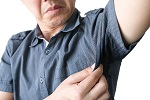
No one wants to be the offender in a crowded room ' the one who's body odor divides the room like Moses at the Red Sea. Yeah, wouldn't want to be that guy, but you know it's not his fault. A microbe in the underarm carries proteins that create chemical reactions that produce the awful smell.
Our skin, just like our gut, has its own distinct microbiome which are microbes that live on our skin. And they're not all the same. The ones in the underarm are unique to that microbiome.
The chemical basis for that BO smell comes from a bacterium called Staphylococcus hominis. This bacterium can convert a chemical from our apocrine sweat glands into the offending pungent thioalcohol ' three-M-three-SH. A protein from the bacterium makes that conversion possible. It comes from a gene that became part of the modern strains of staphylococcus sixty million years ago.
How can scientists be so sure it is this gene and specific protein? They transferred the gene into a non-odor producing Stapylococcus aureus. And guess what ' that recombinant bacteria was now capable of producing BO.
So now scientists have a target to eliminate BO, but it won't help people of East Asian descent. They carry a genetic variation of the apocrine sweat gland that doesn't produce the chemical that the bacteria can modify. So, in other words, they do not have BO.
Pretty unfair, huh? Don't worry. We still have deodorant, but that four-billion-dollar industry will be up in arms if we had our way.
More Information
Know sweat: scientists solve mystery behind body odour
University of York researchers trace the source of underarm aromas to a particular enzyme.
The molecular basis of thioalcohol production in human body odour
Body odour is a characteristic trait of Homo sapiens, however its role in human behaviour and evolution is poorly understood. Remarkably, body odour is linked to the presence of a few species of commensal microbes. Herein we discover a bacterial enzyme, limited to odour-forming staphylococci that are able to cleave odourless precursors of thioalcohols, the most pungent components of body odour.